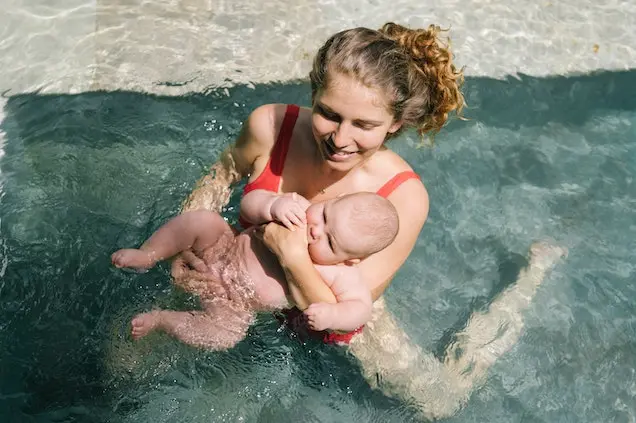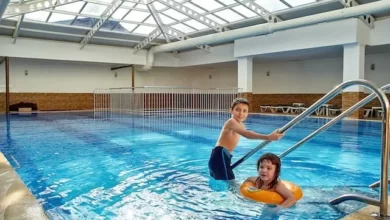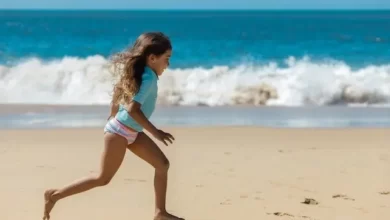9 Tips for a successful swimming lesson

Are you ready to learn a new and exciting water adventure with your little bundle of joy? Baby swimming lesson is a fantastic way to introduce your child to the joy of swimming while promoting water safety and early development. This article will explore 9 essential tips to ensure a successful and enjoyable baby swimming lesson experience. Get ready to dive in and make beautiful memories in the water with your babies.
In this article
How can I choose a safe swimming environment for my baby’s lesson?
when selecting a swimming facility for your baby’s class, it’s essential to prioritize safety. Look for a facility that has a dedicated infant or toddler pool with features designed for their specific needs. This includes a gradual slop for easy entry and exit, as well as shallow water depth that allows your baby to stand comfortably.
Additionally, ensure that the swimming facility maintains appropriate water quality standards, with regular monitoring and testing for chlorine and pH levels. The water temperature should also be kept at a comfortable range for infants, typically between 84 F and 88 F.
Confirm that the pool area is securely fenced and childproofed to prevent accidental access. The gates should be self-closing and self-latching, with childproof locks. Any protruding objects should be eliminated or adequately covered to minimize the risk of injury.
What are the key safety considerations for selecting swimming and accessories?

When choosing swimwear for your baby, prioritize comfort, flexibility and sun protection. Look for swimsuits, made from soft and stretchable materials that allow freedom of movement. opt for one-piece suits or two-piece sets with snug fits to prevent them from riding up or causing discomfort in the water.
To prevent accidents and maintain hygiene, always use swim diapers specifically designed for use in the water. swim diapers are designed to contain solid waste while allowing water to pass through. ensure a secure fit to minimize the risk of leaks.
Avoiding accessories that may hinder movement or pose cooling hazards is important. loose necklaces, bracelets, or hair accessories should be removed before entering the water. Instead, focus on providing your baby with a wide-brimmed hat and UV-protective sunglasses to shield them from the sun’s harmful rays.
How can I ensure constant supervision during baby swimming lessons?
Constant and attractive supervision is essential to ensure your baby’s safety during swimming lessons. Designate a responsible adult who can dedicate their full attention to watching your baby in the water. This individual should have good swimming skills and be capable of responding swiftly in case of an emergency.
Avoid any distractions that may divert your attention away from your baby. This includes avoiding the use of mobile phones or engaging in conversations that take your focus away from the pool. Remember, even a momentary lapse in supervision can have serious consequences, so remain vigilant at all times.
If you need to tend to other matters or take a break, ensure that another responsible adult takes over supervision duties before leaving the pool area. Establish clear communication and a handover process to ensure a smooth transition of responsibility.
What are the recommended ways to support my baby in water safety?
Supporting your baby in the water is crucial to their safety and comfort. Start by ensuring that you always stay within arm’s reach of your baby while they are in or near the water. This proximity allows you to provide immediate assistance if needed.
When holding your baby in the water, support their head and neck. Keep your hand to prevent it from tipping backwards or sideways.
To provide additional support and buoyancy, consider using an appropriate flotation device. Swim rings or floatation suits designed for infants can help keep your baby afloat and allow them to explore the water with added confidence. However, it’s important to note that these devices should never be relied upon as a substitute for supervision.
Gradually introduce submersion under the guidance of a qualified instructor. These techniques help your baby become comfortable with briefly submerging their face in the water. Always follow the instructor’s instructions and take cues from your baby’s readiness and comfort level.
How can I protect my baby from the harmful effect of the sun during swimming lessons?
Safeguarding your little one from the sun is important during swim lessons, as their delicate skin is more susceptible to sunburn and damage. Start by choosing swimwear that provides coverage, including long-sleeved tops and bottoms that protect their arms and legs. Additionally, apply a broad-spectrum sunscreen with a minimum SPF of 30 to The Ultimate Guide to Baby Swimming and Water Safetyexposed areas, such as the face, ears, hands and feet. Be sure to use safe sunscreen for infants and toddlers and reapply it according to the product’s instructions, especially after being in the water.
Consider using a wide-brimmed hat to shade your baby’s face neck, and ears from direct sunlight. sunglasses designed for infants with UV protection can also help protect their eyes from harmful rays.
It’s important to note that sun protection should not be limited to swimming lessons alone. Whether you are at the pool, beach, or any outdoor area, ensure that your baby is adequately protected from the sun’s rays at all times.
What should I do in case of an emergency during baby swimming lessons?
While rare, it’s crucial to be prepared for emergencies during baby swimming lessons. Familiarize yourself with the emergency procedures and exits at the swimming facility. Understand the location of rescue equipment, such as lifebuoys or reaching poles, and know how to use them.
Learning infant CPR and basic first aid techniques is highly recommended for parents and caregivers. These skills can be invaluable in critical situations. Enrol in a certified CPR and first aid course specifically tailored for infants and young children.
It’s equally important to ensure that the swimming instructors are trained in infant CPR and first aid. Inquire about their certifications and qualifications to have peace of mind that they can respond appropriately in case of an emergency.
How can I help my baby develop water confidence while ensuring their safety?
Building water confidence in your baby is a slow process that requires patience and a positive environment. start by introducing your baby to water through gentle water play. Hold them securely in your arms, allowing them to experience the sensation of being in the water while providing reassurance and support.
As your baby becomes more confident and comfortable, gradually introduce new skills and exercise under the guidance of a qualified instructor. These may include kicking, reaching for objects, or floating with assistance. Encourage your baby with praise and reassurance, ensuring they feel safe and supported throughout the process.
It is important to respect your baby’s comfort level and not force them into activities they are not ready for. Every baby progresses at their own pace, so allow them to explore and gradually develop their water skills without undue pressure.
Are there any precautions to take regarding water quality and hygiene during baby swimming lessons?
Yes, maintaining water quality and hygiene is crucial for your baby’s safety during swimming lessons. Ensure that the swimming facility adheres to proper water sanitation practices, including regular monitoring and maintenance of chlorine and ph levels. This helps to prevent the growth of harmful bacteria and viruses in the water.
Encourage parents ND caregivers to practice good hygiene habits before entering the pool with their baby. This includes showering to remove any lotions, oils, or dirt from the skin, as well as ensuring that both the parent and baby are clean and free from any contagious illness or infractions.
Additionally, make it a habit to rinse your baby with clear water after each swimming session. This helps remove residual chlorine or chemicals from their skin and reduces the risk of skin irritation or dryness.
How can I promote water safety awareness beyond swimming lessons for my baby?
promoting water safety practices, such as learning CPR and basic first aid for infants and young children. Consider installing barriers, such as pool fences or safety covers to prevent unsupervised access to the water. These measures are particularly important if you have a pool or open bodies of water.
Teach your baby about water safety rules and boundaries as they grow older. Emphasize the importance of not entering the water without adult supervision and never swimming alone. Encourage open communication about water safety and address any concerns or fears your baby may have.
Finally, reinforce the importance of water safety as your baby grows. Attend refresher courses or workshops on water safety to stay updated with the test guidelines and recommendations. By instilling a strong foundation of water safety awareness, you can help ensure your baby’s safety in and around water throughout their lives.
Conclusion:
Safety should always be the top priority for baby swimming lessons. By following these detailed safety tips you can create a secure and enjoyable environment for your little swimmer. Choose a safe swimming facility, and select the appropriate swimwear and accessories, provide constant and attentive supervision, support your baby in the water safely. Protect your baby from the sun’s warm harmful rays, be prepared for emergencies and roster water confidence gradually. With these measures in place, you can ensure a safe and enriching experience as your baby develops essential swimming skills and life-long love for the water.





